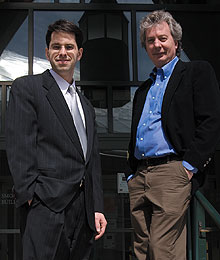  |
| HOME | THIS ISSUE | CALENDAR | GRANTS | BACK ISSUES | < BACK | NEXT > |
Wrongful discharge laws increase cost of doing business, study shows by David Bauman - April 14, 2008 | ||||
| State laws to protect workers from being unfairly sacked have an unintended consequence: they contribute to companies’ becoming less profitable. Moreover, as the list of legal protections against wrongful discharge has grown during the past four decades, salary costs have gone up too. These are the findings of a study by two UConn business professors to be published in the Journal of Law and Economics in May 2009. The study by Robert Bird and John Knopf, “Do Wrongful Discharge Laws Impair Firm Performance?” is one of the first to provide empirical evidence of the economic costs of these laws on firms. “Scholars and policymakers have been debating for years whether legislating job security was bad for business,” says Knopf, an assistant professor of finance. “Now we know that giving employees too many protections increases the financial burden on companies that hire them.” The professors surveyed more than 20 years of wrongful discharge laws across the United States, then compared that information with data from banks on the costs of operating in each of the 50 states. They found that enforcement of wrongful discharge laws – while offering protection against arbitrary or unfair firings – impedes employers’ performance. These findings underscore a significant consideration for state policymakers to ponder in difficult economic times, says Bird, an assistant professor of marketing specializing in business law: “If a state wants to attract business but makes it hard to hire and fire people, companies are less likely to come.” The growth of state laws designed to curb wrongful discharge has made it far more challenging and costly for employers to fire an employee, says Bird. He notes that most workers have jobs that are covered by some wrongful discharge legal protection and that more than 10,000 wrongful discharge lawsuits are filed in state courts each year. The cost of wrongful discharge litigation is huge. Jury awards, for example, can reach hundreds of thousands of dollars. In California during the 1980s, when wrongful discharge protection there was at its peak, the average wrongful discharge jury award was more than $388,000. Today, employers’ concerns about the legal minefield of employment support an entire industry dedicated to advising and protecting firms against wrongful discharge litigation.
Until the 1960s, “employment at will” – which allowed firms to give employees a “pink slip” for any reason – prevailed as the legal rule regulating employment. But starting in 1959, when a California court ruled that a worker could not be fired for refusing to commit perjury, a growing number of legal exceptions have been imposed by courts. Today 43 states, including Connecticut, recognize at least one of three categories of illegal firings. These are: public policy, such as forcing a worker to participate in an illegal act; implied contracts that can create enforceable terms that trump written contracts; and good faith policy, that prevents a firm firing a worker one day shy of qualifying for a pension, for example. To examine the economic effect of job security protections, the researchers decided to study the impact of state wrongful discharge laws on bank performance. Because state laws vary in the scope of their job protection, and Congress, until recently, restricted state-chartered banks to operating in a single state, “comparing the two data sets offered a novel empirical way of matching widely available bank data with state employment law,” says Knopf. In their study, Bird and Knopf conclude: “We find that wrongful discharge laws increase salary costs and reduce the profitability of employers within a given state.” This is because wrongful discharge laws – despite their intended aim of providing job security – not only hinder performance by imposing litigation costs on firms, they also cause many employers to shy away from hiring new workers, because they fear being taken to court, say Bird and Knopf. In addition, wrongful discharge laws may embolden employees to demand higher salaries in exchange for refraining from legal action, notes Bird. “That’s not necessarily a good thing,” he adds. “Higher salaries mean that firms are less willing to hire, and that means fewer jobs available for people who are unemployed or are looking to switch. On the other hand, the more firms are allowed to hire and fire, the more they reward good employees and the more willing they are to grow the business.” |
| ADVANCE HOME UCONN HOME |

